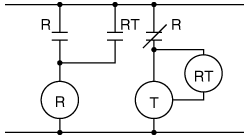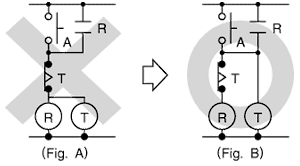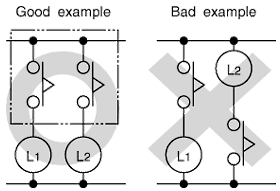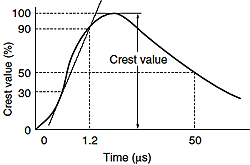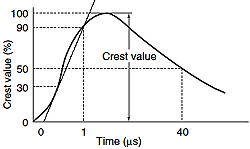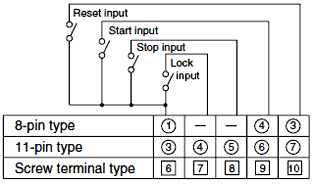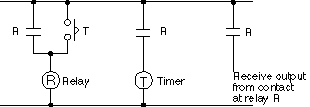[System Maintenance Notice]
Due to ongoing system maintenance, the site search and specification search functions are temporarily unavailable. We apologize for any inconvenience this may cause and appreciate your understanding.
【Notification of Manufacturer Change for Panasonic Industrial Devices SUNX Products and Panasonic Industrial Devices SUNX Tatsuno Products】
From April 1, 2024, the terms "Panasonic Industrial Devices SUNX Co., Ltd." and "Panasonic Industrial Devices SUNX Tatsuno Co., Ltd."
in this page and in the manuals and other documents to be downloaded will all be replaced with "Panasonic Industry Co., Ltd." and applied accordingly.
 Business
> Industrial Devices
> Automation Controls Top
> FA Sensors & Components
> Timers / Counters / FA Componets
> Timers
> LT4H-L Digital Timers(DIN 48)(Discontinued Products)
> Cautions For Use
Business
> Industrial Devices
> Automation Controls Top
> FA Sensors & Components
> Timers / Counters / FA Componets
> Timers
> LT4H-L Digital Timers(DIN 48)(Discontinued Products)
> Cautions For Use
LT4H-L Digital Timers(DIN 48) (Discontinued Products)
|
We are sorry, the products have been discontinued. Please refer to the details of the discontinued products and the recommended substitutes list below.
|
|
Cautions For Use
Timers Cautions for Use (Common for All Models)
Cautions for circuits
1.Protective circuit for timer contact
In the circuit that switches an inductive load, a contact failure may occur at a contact point due to surge or inrush current resulting from that switching.
Therefore, it is recommended that the following protective circuit be used to protect the contact point.
| Circuit | Application | Features/Others | Device Selection | |||
|---|---|---|---|---|---|---|
| AC | DC | |||||
| CR circuit (r: resistor c: capacitor) |
 |
* Note: | Available | If the load is a relay or solenoid, the release time lengthens.Effective when connected to both contacts if the power supply voltage is 24 or 48 V and the voltage across the load is 100 to 200 V. | If the load is a timer, leakage current flows through the CR circuit causing faulty operation. Note: If used with AC voltage, be sure the impedance of the load is sufficiently smaller than that of the CR circuit. |
As a guide in selecting r and c, c: 0.5 to 1 µF per 1 A contact current r: 0.5 to 1 ohm; per 1 V contact voltage Values vary depending on the properties of the load and variations in timer characteristics. Capacitor c acts to suppress the discharge the moment the contacts open. Resistor r acts to limit the current when the power is turned on the next time. Test to confirm. Use a capacitor with a breakdown voltage of 200 to 300 V. Use AC type capacitors (non-polarized) for AC circuits. |
| - | ||||||
 |
Available | Available | ||||
| Diode circuit |  |
N/A | Available |
The diode connected in parallel causes the energy stored in the coil to flow to the coil in the form of current and dissipates it as joule heat at the resistance component of the inductive load. This circuit further delays the release time compared to the CR circuit.(2 to 5 times the release time listed in the catalog) |
Use a diode with a reverse breakdown voltage at least 10 times the circuit voltage and a forward current at least as large as the load current. In electronic circuits where the circuit voltages reverse breakdown voltage of about 2 to 3 times the power supply voltage. |
|
| Varistor circuit |  |
Available | Available | Using the rated voltage characteristics of the varistor, this circuit prevents excessively high voltages from being applied across the contacts. This circuit also slightly delays the release time. Effective when connected to both contacts if the power supply voltage is 24 or 48 V and the voltage across the load is 100 to 200 V. |
- | |
2.Type of Load and Inrush Current
The type of load and its inrush current characteristics, together with the switching frequency are important factors which cause contact welding. Particularly for loads with inrush currents, measure the steady state current and inrush current and use a relay or magnet switch which provides an ample margin of safety. The table below shows the relationship between typical loads and their inrush currents.
| Type of load | Inrush current |
|---|---|
| Resistive load | Steady state current |
| Solenoid load | 10 to 20 times the steady state current |
| Motor load | 5 to 10 times the steady state current |
| Incandescent lamp load | 10 to 15 times the steady state current |
| Mercury lamp load | 1 to 3 times the steady state current |
| Sodium vapor lamp load | 1 to 3 times the steady state current |
| Capacitive load | 20 to 40 times the steady state current |
| Transformer load | 5 to 15 times the steady state current |
When you want large load and long life of the timer, do not control the load direct with a timer. When the timer is designed to use a relay or a magnet switch, you can acquire the longer life of the timer.
3.Connection of input
Since PM4H and LT4H series timers use a transformerless power supply system, the input equipments must have the power supply transformer in which the secondary side is not grounded with the primary and secondary sides insulated, in order to prevent interference of the power supply circuit when connecting the external input circuit as Fig. A.
Be sure not to use an autotransformer. In case of secondary side grounded or using the autotransformer, this product may be destroyed due to short circuit electrically as Fig. B (1 and 2).
In case of F.G. terminal of equipments such a PLC grounded in secondary side of the transformer, inner circuits of this product and the input equipment may be destroyed due to short circuit electrically as Fig.B (3).
Therefore, use the isolated type timers or do not ground F.G. terminal of the products.
|
4.Long Continuous Current Flow
Long continuous current flow through the timer (approx. one month or longer) cause generation of heat internally, which degrade the electronic parts. Use the timer in combination with a relay and avoid long continuous current flow through the timer.
|
|
5.Leakage current
- 1.For connecting and disconnecting operating voltage to the timer, a circuit should be used, which will prevent the flow of leakage current. For example, a circuit for contact protection as shown in Fig A. will permit leakage current flow through R and C, causing erroneous operation of the timer. Instead, the circuit shown in Fig. B should be used.
|
- 2.If the timer is directly switched with a non-contact element, leak current may flow into the timer and cause it to malfunction.
6.Power off time
If the operation voltage for the timer is turned ON after the limit time operation is completed or before the limit time is reached, the Power off time longer than the timer restoration time must be secured.
7.Suicide circuit
If the timer is restored immediately after the specified time is reached, the circuit must be configured so that the restoration time of the timer can be secured sufficiently.
If the power circuit for the timer is turned OFF with the timer contact, a suicide circuit may be configured (Fig. A). In order to settle the problem with this potential suicide circuit, the circuit must be designed so that the timer is turned OFF after the self-retention circuit is completely released (Fig. B).
|
8.Electrical life
The electrical life varies depending on the load type, the switching phase, and the ambient atmosphere. In particular, the following cases require careful attention:
- 1.If an AC load is switched in synchronized phases:Locking or welding is liable to occur due to contact transposition. Check this with the actual system.
- 2.If a load is switched very frequently:
If a load which generates arcs when a contact is switched is turned ON and OFF very frequently, nitrogen and oxygen in air are combined due to arc energy and then HNO3 is produced. This may corrode metallic materials.
The effective countermeasures include:
- 1.Using an arc-extinguishing circuit;
- 2.Decreasing the switching frequency; and
- 3.Decreasing the humidity in the ambient atmosphere.
9.Pin connections
Correctly connect the pins while seeing the pin layout/connection diagram. In particular, the DC type, which has polarities, does not operate with the polarities connected reverse. Any incorrect connection can cause abnormal heating or ignition.
10.Connection to operation power supply
- 1.Supply voltage must be applied at a time through a switch, a relay, and other parts. If the voltage is applied gradually, the specified time may be reached regardless of its value or the power supply may not be reset.
- 2.The operation voltage for the DC type must be at the specified ripple percentage or less. The average voltage must fall within the allowable operation voltage range.
- 3.Make sure that no induced voltage and residual voltage are applied between the power pins on the timer after the power switch is turned OFF.
| Rectification type | Ripple percentage |
|---|---|
| Single-phase, full-wave | Approx. 48% |
| Three-phase, full-wave | Approx. 4% |
| Three-phase, half-wave | Approx. 17% |
11.Control output
- 1.The load for the control output must be used within the load capacity specified in the rated control capacity. If it is used exceeding the rated value, the life is greatly shortened.
- 2.The following connection might result in short circuit between the heteropolar contacts in the timer.
|
12.Installing the timer
- 1.To install the timer, use the dedicated pin bracket or socket (cap). Avoid connecting the pins on the timer by directly soldering them.
- 2.In order to maintain the characteristics, do not remove the timer cover (case).
13.Superimposed surge of power supply
For the superimposed surge of power supply, the standard waveform (±1.2×50μs or ±1×40μs) is taken as the standard value for surge-proof voltage.
(The positive and negative voltages are applied each three or five times between the power pins.)
For the standard values for the PM4H, LT4H, and S1DX type timers, see the respective items in "Caution on usage."
|
|
PMH [±(1×40)μs]
| Voltage type | Surge voltage |
|---|---|
| AC type (except 24V AC) | 4,000V |
| 12V, 24V DC, 24V AC | 500V |
Other timers [±(1×40)μs]
| Type | Surge voltage |
|---|---|
| PNS CN-C CHP, CHP-F | 20 times rated voltage |
| CHP-SD | 4,000V |
If external surge occurs exceeding the specified value, the internal circuit may break down. In this case, use a surge absorption element. The typical surge absorption elements include a varistor, a capacitor, and a diode. If a surge absorption element is used, use an oscilloscope to see whether or not the foreign surge exceeding the specified value appears.
14.Changing the set time
Do not change the set time when the limit time operation is in progress.
However, this is possible only with the motor-driven type timer if the set time is shorter than the remaining time. For changing the set time on the digital timer (LT4H), see the relevant item in "Caution on use."
15.Operating environment
- 1.Use the timer within the ambient temperature range from -10°C to +50°C/ +14°F to +122°F (+55°C/ +131°F for the LT4H series) and at ambient humidity of 85% RH maximum.
- 2.Avoid using the timer in a location where (a) inflammable or corrosive gas is generated, (b) the timer is exposed to much dust and other foreign matter; (c) water or oil is splashed on the timer; or (d) vibrations or shocks are given to the timer.
- 3.The timer cover (case), the knobs, and the dials are made of polycarbonated resin. Therefore, prevent the timer from being exposed to organic solvents such as methyl alcohol, benzine, and thinner, strong acid substances such as caustic soda, and ammonia and avoid using the timer in atmosphere containing any of those substances.
- 4.If the timer is used where noises are emitted frequently, separate the input signal elements (such as a sensor), the wiring for the input signal line, and the timer as far as possible from the noise source and the high power line containing noises.
16.Checking the actual load
In order to increase the reliability in the actual use, check the quality of the timer in the actual usage.
17.Others
- 1. If the timer is used exceeding the ratings (operation voltage and control capacity), the contact life, or any other specified limit, abnormal heat, smoke, or ignition may occur.
- 2. If any malfunction of the timer is likely to affect human life and properties, give allowance to the rated values and performance values. In addition, take appropriate safety measures such as a duplex circuit from the viewpoint of product liabilities.
LT4H-L Series Cautions For Use
1.Terminal wiring
- 1.When wiring the terminals, refer to the terminal layout and wiring diagrams and be sure to perform the wiring properly without errors.
- 2.When using the instrument with an embedded installation, the screw-down terminal type is recommended. For the pin type, use either the rear terminal block (AT8-RR) or the 8P cap (AD8-RC) for the 8-pin type, and the 11P cap (AT8-DP11) for the 11-pin type. Avoid soldering directly to the round pins on the unit. When using the instrument with a front panel installation, use the DIN rail terminal block (ATC18003) for the 8-pin type and the DIN rail terminal block (ATC18004) for the 11-pin type.
- 3.After turning the unit off, make sure that any resulting induced voltage or residual voltage is not applied to power supply terminals (2) through (7) (8pin type)(2) through (10) (11pin type) or [1] and [2] (screw-down terminal type). (If the power supply wire is wired parallel to the high voltage wire or power wire, an induced voltage may be generated between the power supply terminals.)
- 4.Have the power supply voltage pass through a switch or relay so that it is applied at one time. If the power supply is applied gradually, the counting may malfunction regardless of the settings, the power supply reset may not function, or other such unpredictable occurrence may result.
2.Input connections
The power circuit has no transformer. When an input signal is applied to two or more timers at once, do not operate the power circuit in an independent way. If the timer is powered on and off independently as shown in Fig.A, the timer's internal devices may get damaged. Be careful never to allow such wiring. (Figs. A, B and C show the circuitly for the 11-pin type.)
|
If independent power operation must be used, keep the input contacts or transistors separate respectively, as shown in Fig.B.
|
When power operation is not independent, one input signal can be applied to two or more counters at once, as shown in Fig.C.
|
3.Input and output
1.Signal input type
- 1.Contact point input
Use highly reliable metal plated contacts. Since the contact point's bounce time leads directly to error in the timer operations, use contacts with as short a bounce time as possible. Also, select a minimum input signal width of 20 ms.
|
- 2.Non-contact point input
Connect with an open collector. Use transistors whose characteristics satisfy the criteria given below.
VCEO = 20 V min.
IC = 20 mA min.
ICBO =6 μA max.
Also, use transistors with a residual voltage of less than 2 V when the transistor is on.
|
| * | The short-circuit impedance should be less than 1 kohm. [When the impedance is 0 W, the current coming from the signal input and stop input terminals is approximately 12 mA, and from the reset input and lock input terminals is approximately 1.5 mA.] Also, the open-circuit impedance should be more than 100 kohm. |
|---|---|
| * | As shown in the diagram below, from a non-contact point circuit (proximity switches, photoelectric switches, etc.) with a power supply voltage of between 12 and 40 V, the signal can be input without using an open collector transistor. In the case of the diagram below, when the non-contact point transistor Q switches from off to on (when the signal voltage goes from high to low), the signal is input. |
|
2.The input mode and output mode change depending on the DIP switch settings. Therefore, before making any connections, be sure to confirm the operation mode and operation conditions currently set.
3.LT4H series timers use a transformerless power supply system, the input equipments must have the power supply transformer in which the secondary side is not grounded with the primary and secondary sides insulated, in order to prevent interference of the power supply circuit when connecting the external input circuit as Fig. A.
Be sure not to use an autotransformer. In case of secondary side grounded or using the autotransformer, this product may be destroyed due to short circuit electrically as Fig. B (1 and 2).
In case of F.G. terminal of equipments such a PLC grounded in secondary side of the transformer, inner circuits of this product and the input equipment may be destroyed due to short circuit electrically as Fig.B (3).
Therefore, use the isolated type timers or do not ground F.G. terminal of the products.
Once the wiring to be used is completely installed and prior to installing this timer, confirm that there is complete insulation between the wires connected to the power terminals (2 each) and the wires connected to each input terminal. If the power and input lines are not insulated, a short-circuit may occur inside the timer and result in internal damage. In addition, when moving your equipment to a new installation location, confirm that there is no differences in environmental conditions as compared to the previous location.
|
4.The input signal is applied by the shorting of each input terminal with the common terminal (terminal (1) for 8-pin types, terminal (3) for 11-pin types and terminal [6] for screw-down terminal types). Never connect other terminals or voltages higher than DC 40 V, because it may destroy the internal devices.
5.Transistor output
- 1.(1) Since the transistor output is insulated from the internal circuit by a photocoupler, it can be used as an NPN output or PNP (equal value) output. (The above example is 11-pin type)
|
- 2.Use the diode connected to the output transistor's collector for absorbing the reverse voltage from induced loads.
|
6.When wiring, use shielded wires or metallic wire tubes, and keep the wire lengths as short as possible.
7.For the load of the controlled output, make sure that it is lower than the rated control capacity.
4.Operation of LT4H digital timer
- 1.Turning on and off the power supply while operating in A2* (Power on delay
- 2.or G (Totalizing On delay) will result in a timer error to be generated due to the characteristics of the internal circuitry.Therefore, use the start input or stop input.
| * | Not related to the start input. |
|---|
- 3.When controlling the timer by turning on the power supply, use only A (Power on delay 1) or A2 (Power on delay 2).Use of other modes in this situation will result in timer errors. When using the other modes, control the timer with the start input or stop input.
5.Operation mode and time range setting
The operation mode and time range can be set with the DIP switches on the side of the timer. Make the DIP switch settings before installing the timer on the The operation mode of LT4H-W series can be set with the keys and switches on the front of the timer.
6.Conditions of usage
- 1.Avoid locations subject to flammable or corrosive gases, excessive dust, oil, vibrations, or excessive shocks.
- 2.Since the cover of the unit is made of polycarbonate resin, avoid contact with or use in environments containing methyl alcohol, benzene, thinners, and other organic solvents; and ammonia, caustic sodas, and other alkaline substances.
- 3.If power supply surges exceed the values given below, the internal circuits may become damaged. Be sure to use surge absorbing element to prevent this from happening.
| Operating voltage | Surge voltage(peak value) |
|---|---|
| AC type | 6,000V |
| DC type 24V AC type |
1,000V |
|
- 4.Regarding external noise, the values below are considered the noise-resistant voltages. If voltages rise above these values, malfunctions or damage to the internal circuitry may result, so take the necessary precautions.
| Power supply terminals | Input terminals | ||
|---|---|---|---|
| AC type | DC type 24V AC type |
||
| Noise voltage | 1,500V | 1,000V | 600V |
wave form (noise simulator)
Rise time: 1 ns
Pulse width: 1 μs, 50 ns
Polarity: ±
Cycle: 100 cycles/second
- 5.When connecting the operation power supply, make sure that no leakage current enters the counter. For example, when performing contact protection, if set up like that of diagram A, leaking current will pass through C and R, enter the unit, and cause incorrect operation. Diagram B shows the correct setup.
|
- 6. Long periods of continuous operation in the count-up completed condition (one month or more) will result in the weakening of the internal electrical components from the generated heat and, therefore, should be avoided. If you do plan to use the unit for such continuous operation, use in conjunction with a relay as shown in the circuit in the diagram below.
|
7.Acquisition of CE marking
Please abide by the conditions below when using in applications that comply with EN61812-1.
1.Overvoltage category III, pollution level 2
2.This timer employs a power supply without a transformer, so the power and input signal terminals are not insulated.
- 1.When a sensor is connected to the input circuit, install double insulation on the sensor side.
- 2.In the case of contact input, use dualinsulated relays, etc.
3.The load connected to the output contact should have basic insulation.
This timer is protected with basic insulation and can be double-insulated to meet EN/IEC requirements by using basic insulation on the load.
4.Please use a power supply that is protected by an overcurrent protection device which complies with he EN/IEC standard (example: 250 V 1 A fuse, etc.).
5.You must use a terminal socket or socket for the installation. Do not touch the terminals or other parts of the timer when it is powered. When installing or un-installing, make sure that no voltage is being applied to any of the terminals.
6.Do not use this timer as a safety circuit.For example when using a timer in a heater circuit, etc., provide a protection circuit on the machine side.
BY EMAIL
- U.S.A.
- +1-800-344-2112
- Europe
- +49-89-45354-1000
- China
- +86-10-59255988
- Singapore
- +65-6299-9181
Requests to customers (Automation Control Components & Industrial Device) [Excluding specific product]
Requests to customers (Automation Control Components & Industrial Device) [For specific product]
Requests to customers (FA Sensors & Components [Excluding motors])
Requests to customers (Dedicated to industrial motors)
- COMPONENTS & DEVICES
- FA SENSORS & COMPONENTS
- Fiber Sensors
- Photoelectric Sensors / Laser Sensors
- Micro Photoelectric Sensors
- Light Curtains / Safety Components
- Area Sensors
- Inductive Proximity Sensors
- Particular Use Sensors
- Sensor Options
- Wire-Saving Systems
- Programmable Controllers / Interface Terminal
- Human Machine Interface
- Pressure Sensors / Flow Sensors
- Measurement Sensors
- Static Control Devices
- Laser Markers / 2D Code Readers
- Machine Vision System
- Energy Management Solutions
- Timers / Counters / FA Components
- MOTORS





